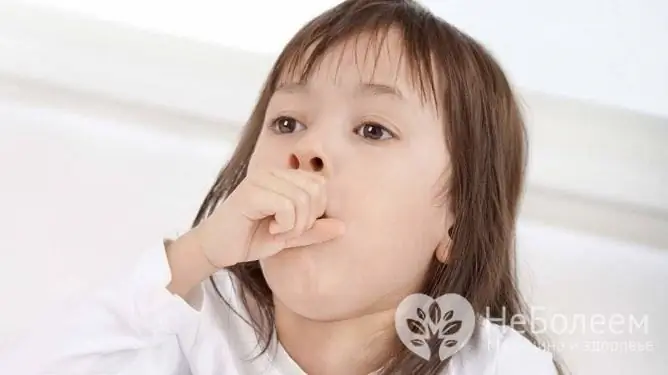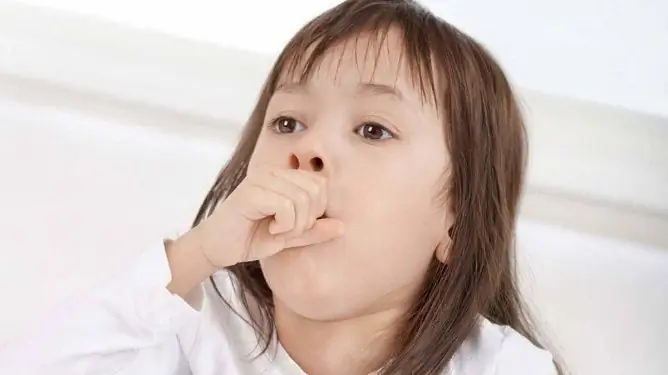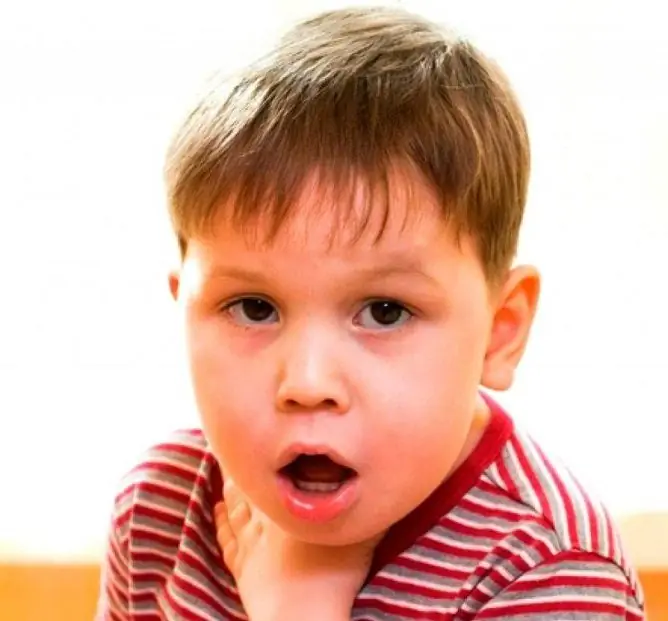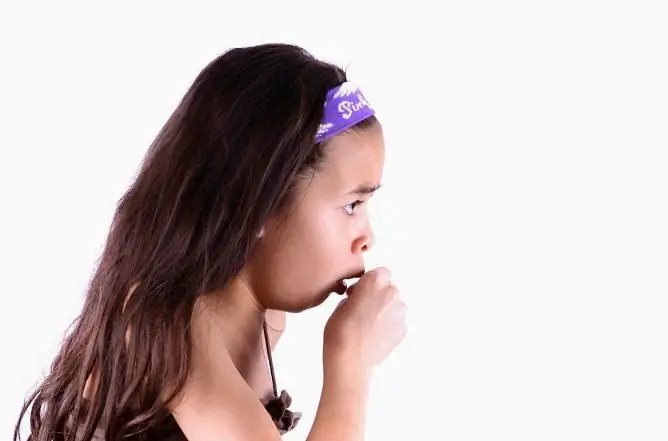- Author Rachel Wainwright [email protected].
- Public 2023-12-15 07:39.
- Last modified 2025-11-02 20:14.
Residual cough in a child: how to treat and when to do it
The content of the article:
- What is residual cough
- Why is developing
-
How to treat a residual cough in a child
- General recommendations
- Drug treatment
- Inhalation
- Vibration massage
- Folk remedies
- What symptoms should alert
- Residual cough does not go away: what to do
- Prevention of post-infectious cough
- Video
Residual cough in a child is often observed after suffering respiratory tract infections. The general condition has already returned to normal, but dry or wet cough worries.

In most cases, residual cough is not dangerous and does not require treatment
What is residual cough
Residual cough is the last symptom of respiratory diseases. This phenomenon is observed when all the symptoms have already disappeared, and the cough does not go away, it can persist for 3-8 weeks. Coughing is a defense reflex that clears the bronchi and upper airways of remaining mucus. This mechanism in most cases avoids complications - the accumulation of sputum and subsequent inflammation.
Why is developing
The mucous membrane of the upper respiratory tract has a protective function. This is achieved due to the presence of mucociliary clearance - a purification system that is represented by two components:
- Cilia are outgrowths of the epithelium. Moving in the direction of the nasal cavity, they remove foreign particles from the bronchi.
- Bronchial mucus is produced by the bronchial glands. Foreign particles (dust, microorganisms, pus) dissolve in mucus, which facilitates their excretion.
With inflammation of the upper respiratory tract, the mucous membrane is damaged. This is accompanied by a decrease in the protective function - cleansing from foreign particles.
It takes time to restore the mucous membrane, on average three weeks. At this time, a residual cough is observed, which occurs due to the consequences of the underlying disease - damage to the mucous membrane.
What diseases can cause residual cough:
- laryngitis;
- tracheitis;
- bronchitis;
- pneumonia.
A prolonged cough can be the result of acute respiratory diseases (ARI) - viral and bacterial.
How to treat a residual cough in a child
As a rule, no specific treatment is required in this case. You just need to help the body realize its own compensatory capabilities.
To get rid of a lingering cough, you need to moisturize and envelop the mucous membrane. For this purpose, inhalations, medications, air humidification, folk remedies are used. The child will more easily endure a post-infectious cough if it is easier to remove sputum. For this, vibration massage is prescribed, taking herbal expectorants.
General recommendations
The child's recovery and the duration of residual symptoms are affected by the adequacy of the treatment of the underlying disease.
General recommendations will help completely eliminate the symptoms of the disease:
- Drinking more fluids will reduce the viscosity of the phlegm. Give your child plain water, warm tea, compote, fruit drink, non-acidic fruit juice, milk. It doesn't really matter what exactly he drinks, it is important that he drinks more.
- Avoid hypothermia.
- Ventilate the child's room, carry out daily wet cleaning.
General recommendations do not directly affect the cough, but contribute to the child's recovery.
Drug treatment
Drug treatment for post-infectious cough is not shown to everyone. Indications for the use of medicines:
- Viscous, difficult sputum.
- Difficulty breathing.
- Paroxysmal cough.
When breathing is difficult, bronchodilators are prescribed - drugs that expand the lumen of the bronchi. For post-infectious cough, the drug of choice is Ipratropium bromide (Atrovent). It reduces the action of the vagus nerve - expands the lumen of the bronchi, reduces the secretion of bronchial mucus. Atrovent prevents the narrowing of the bronchi, which occurs as a result of inhalation of cold air, cigarette smoke.
With a wet cough with viscous sputum, expectorant drugs are prescribed. Preference is given to medicines with herbal composition. For example, preparations based on Althea root (Mukaltin, Alteika syrup) or Thermopsis herb. Such drugs have a reflex effect - they increase the secretion of mucus and the activity of the ciliated epithelium. Thanks to this, the excretion of sputum improves, and irritation of the cough receptors decreases.
For older children, synthetic mucolytics and surfactant synthesis stimulants are used:
- Acetylcysteine;
- Ambroxol;
- Bromhexine.
These drugs thin phlegm and improve mucociliary clearance.
With a debilitating cough, which is paroxysmal, antitussive drugs may be prescribed. They are not indicated in the routine treatment of post-infectious cough.
For children, antitussives of peripheral action are more often used, for example, Libexin. Drugs in this group have a local anesthetic effect - they reduce the sensitivity of the receptors in the respiratory tract.
Antitussive drugs inhibit expectoration, therefore they are contraindicated for use with a wet cough and together with mucolytics.
Inhalation
Inhalation moisturizes the lining of the respiratory tract. Older children (after 7 years) can use steam inhalation:
- decoctions of medicinal herbs (chamomile, sage);
- water and soda;
- saline.
For inhalation, you can use a special device - a nebulizer. The effectiveness of inhalation by a nebulizer is higher, since medicinal substances are delivered to the smallest branches of the bronchi. Young children are given only nebulizer inhalation.
Vibration massage
Vibration massage promotes the discharge of phlegm. You can also do massage at home:
- Lay the baby on its stomach.
- Tap lightly with the edge of your palm on your back (it is better if your fingers are open).
- Perform the procedure for 5-10 minutes.
You can repeat the massage 2-3 times a day for a week.

Vibration massage helps speed up recovery from bronchopulmonary diseases
Folk remedies
Folk recipes for a prolonged cough can relieve the condition of the child. But it must be remembered that folk recipes are not a panacea, and if not used according to indications, they can worsen the condition.
For post-infectious cough, the following folk remedies can be used:
- warm milk with honey;
- decoction of chamomile;
- rubbing the chest with interior fat.
What symptoms should alert
Post-infectious cough alone is not dangerous for babies. It is important to make sure that the cough is really residual, and does not indicate the development of reinfection, relapse or complications.
How to distinguish a residual cough from a serious pathology:
| Symptom name | Residual cough | Cough with reinfection or complications |
| Body temperature | Absent | Rises to subfebrile or febrile digits (37-38 ° C) |
| General well-being | Not impaired: the child is active, except for coughing nothing bothers | Disordered: child is lethargic, complains of weakness and fatigue |
| Cough productivity | Dry or wet (with little mucous expectoration) | Moist, may be accompanied by the discharge of mucopurulent, purulent sputum |
| Features of cough | Moderate, may manifest as mild coughing | Paroxysmal, intense, may result in vomiting |
Residual cough does not go away: what to do
If the cough continues for more than 8 weeks after recovery, parents should be alert. Especially if, in addition to coughing, there is an increase in temperature, a violation of health, the release of purulent sputum.
The first thing to do in this case is to see a doctor. He will examine the child, perform auscultation of the lungs, and order additional tests. If wheezing is heard in the lungs, this may indicate the development of bronchitis. In this case, the appointment of antibacterial agents may be necessary.
Chronic cough can be a symptom of many medical conditions. Should not be delayed with the diagnosis and treatment.
Prevention of post-infectious cough
Post-infectious cough develops in 11-25% of ARVI cases. In most cases, complete recovery occurs, but complications may develop:
- chronicity of cough;
- accession of a bacterial infection;
- tracheobronchial dyskinesia;
- hoarseness of voice.
To avoid complications, it is necessary to carry out adequate therapy for the underlying disease. Some respiratory diseases can be prevented by vaccination (for example, whooping cough and influenza).
Video
We offer for viewing a video on the topic of the article.

Anna Kozlova Medical journalist About the author
Education: Rostov State Medical University, specialty "General Medicine".
Found a mistake in the text? Select it and press Ctrl + Enter.






